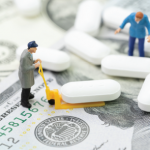Biosimilar drugs may create some price competition, although for the first batch of products, the price discounts seem paltry and are likely lining the pockets of the PBMs. Of course, drug manufacturers may finally decide to compete on price, a tactic that until now, they have steadfastly avoided. Paradoxically, ocrelizumab, a newly marketed drug to treat multiple sclerosis, was priced about 40% lower than its competitor, interferon-beta-1a, even though it showed superior outcomes in two head-to-head clinical trials.9 Could this be the start of a trend?
There is one other powerful option, one with the innocent-sounding moniker of march-in. This term refers to a federal law that was enacted by the Bayh-Dole Act (1980) that encouraged institutions “to use the patent system to promote the utilization of inventions arising from federally supported research or development.”10 It asserts that the federal government still maintains patent rights when inventions or discoveries are made with their support, such as funding from the National Institutes of Health (NIH). Using data on patents linked to NIH grants over a 27-year period, a recent study found that about 10% of grants generate a patent directly and 30% generate articles that are subsequently cited by patents. There was an equal propensity for basic and translational research to be cited by a patent.11
Federally funded research generates sizable numbers of patents, and in theory, the government could march in and reclaim the patent from its holder if specific circumstances warrant such actions. For example, it may be used “to alleviate health or safety needs that are not reasonably satisfied by the contractor, assignee or licensees.”10
The feds carry a big stick, but has it ever been used? Over the past decade, there have been five occasions on which the NIH, in response to requests that it exercise those rights, has issued determinations in which it explained its rationale for declining to exercise march-in rights. In three of those determinations, the petitioners raised pricing as the basis for requesting the exercise of march-in rights. The NIH rationalized that, “because the market dynamics for all products developed pursuant to licensing rights under the Bayh-Dole Act could be altered if prices on such products were directed in any way by the NIH, the NIH agrees with the public testimony that suggested that the extraordinary remedy of march-in is not an appropriate means of controlling prices. The issue of whether drugs should be sold in the U.S. for the same price as they are sold in Canada and Europe has global implications and, thus, is appropriately left for Congress to address legislatively.”10



